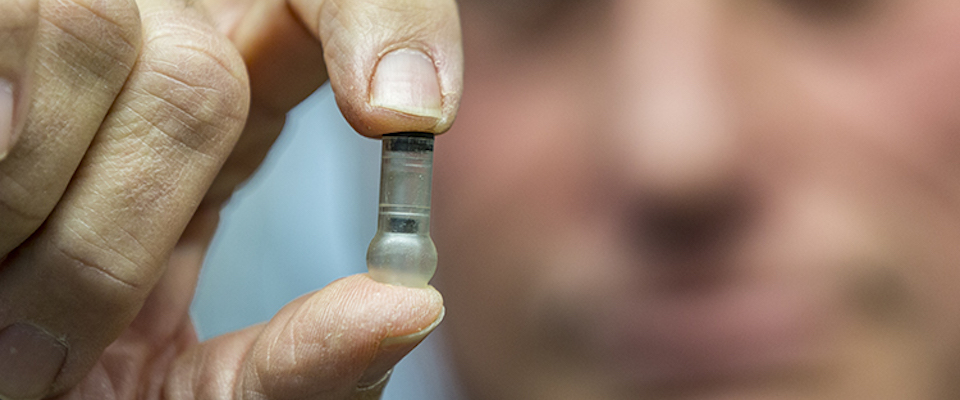A group of UC researchers has created a small motion-detecting control device for consumer electronics that uses bat-like ultrasonic echolocation, which means…
Na na na na na na na na na na na na na na na na… BATPHONE!
Or possibly Batwatch, or BatGPS, or Batslideshow-controller, or Batscreen with gestural interface. Really, the possibilities are endless within the realm of electronic devices you could control by waving your hand—like, say, a miniature symphony orchestra, or the stereo in the Batmobile.
The device was developed cooperatively between researchers at UC Berkeley and UC Davis, who have since started a small company called Chirp Microsystems. (The ultrasonic noises bats emit as they echolocate are called, yes, chirps.)
The device—we’ll just call it Chirp—uses a tiny, seven-speaker transducer to send out pulses of ultrasonic sound and to receive their echos. The echoes return to the transducer at different times depending on the distance and angle of the object off of which they reflect. An electronic chip about the size of the transducer then analyzes these echoes. Richard Przybyla, a Cal engineering Ph.D. student and co-founder of the company, worked on the electronic system that deciphers the data produced by the device’s chirps. The device uses the timing and angle of these echoes to construct what he calls “a three-dimensional map of what’s out there,” within a range of about one meter.
He says that the system is small enough to fit onto mobile devices, where it can augment their controls or, in the case of something the size of a smartwatch, prove more useful than a tiny touch screen.
Counter-intuitively, Chirp’s greatest virtue might be its short-range and slow speed. The gesture controller familiar to many people—the Kinect on the XBox game system—works with light, projecting a grid of infrared light out into space that allows it to map everything to a fairly high resolution within three and a half meters, calculating its data in nanoseconds. The drawbacks of this approach are that the Kinect is fairly bulky (it’s as long as a sheet of printer paper), is farsighted (it can’t see well within one meter of itself) and it consumes so much power that it can’t take in enough energy from a USB connection and requires an additional plug.
This is where Chirp’s echolocation has the advantage. Because it’s focused on a smaller space, it’s pulling in less data. Similarly, because sound is so much slower than light, Chirp only has to process data that’s being relayed in milliseconds instead of nanoseconds, which is three orders of magnitude less data.
All of this means that you can fit Chirp’s components—its ultrasonic transducer, its processor and, if you want, a watch battery that would run them both continuously for 30 hours—into an area roughly one quarter the size of a penny. Bernhard Boser, an advisor to Chirp Microsystems and a Cal professor of electrical engineering and computer science who runs the lab in which Przybyla developed the software, says that the power demands of Chirp are so low that, “for a smartphone it just plain doesn’t matter. It reduces the battery life of your smartphone by maybe a couple of minutes or so. You won’t notice that.”
David Horsley is Chirp Microsystems’ vice president of engineering and a UC Davis professor of mechanical and aerospace engineering. It was his lab that began to develop Chirp’s transducer six years ago, as part of a Defense Department project to create a navigation system for soldiers inside GPS-free environments, such as inside buildings or caves. “It was a pretty far-out application, but it certainly helped us to develop the technology to the point where it is today,” Horsley says.
Chirp is looking for customers interested in using its technology, Horsley says, and from there it can consider manufacturing or licensing.
Oh, and one last thing about bats. Don’t worry, Przybyla says, Chirp shouldn’t bother them. Bats can generally ‘hear” only up to a range of about 100 khz and Chirp operates at 200 khz.
“I don’t think,” Przybyla says, “we’ll be crashing any bats with this technology.”
For the record, there is a bat that has been recorded emitting chirps at around 210 khz, and if so, it can presumably hear in that range. This bat is believed to be confined to areas in south eastern Africa—still, something to bear in mind should you wish to someday wear a gesture-reading smartwatch while visiting Zimbabwe and encountering a Percival’s Trident Bat.




















